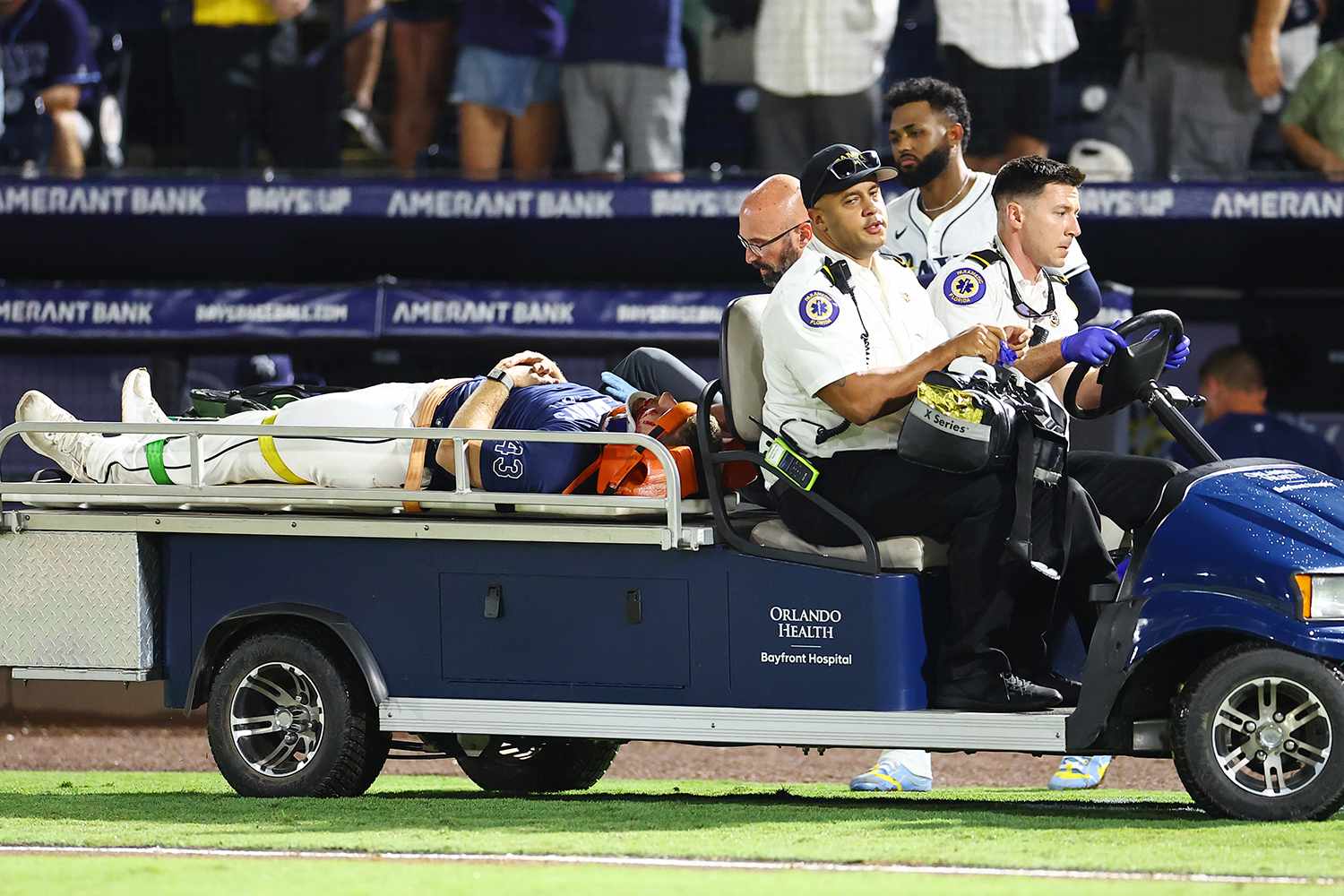The world of professional baseball witnessed a chilling incident on Thursday night, sending a wave of concern through players, staff, and fans alike.
Hunter Bigge, a pitcher for the Tampa Bay Rays, endured a terrifying moment when he was struck by a sharply hit foul ball while in the dugout. The force of the impact was significant, hitting him on the side of the face, leading to an immediate and visibly distressing scene. Emergency medical personnel swiftly attended to Bigge, who was eventually carted off the field and transported to a local hospital for comprehensive evaluation and tests.
This type of incident, though rare, serves as a stark reminder of the inherent dangers that can arise even off the field of play in a fast-paced sport like baseball. Despite the terrifying nature of the blow, initial reports offered a glimmer of hope amidst the concern. Bigge, a 27-year-old right-hander, maintained consciousness throughout the ordeal and was able to communicate with first responders.
This critical detail, relayed by Rays manager Kevin Cash, provided immediate reassurance to those witnessing the event. The well wishes and standing ovation from the crowd at Steinbrenner Field underscored the collective anxiety and support for the injured player. This article will detail the circumstances of the incident, Bigge’s immediate condition, his career background, and the broader implications for player safety.
The Incident: A Line Drive into the Dugout
The incident unfolded rapidly in the top of the seventh inning, bringing the game to an abrupt halt.
The Play that Led to Injury
The unsettling event transpired in the top of the seventh inning of Thursday night’s game between the Tampa Bay Rays and the Baltimore Orioles. The focus of the game momentarily shifted to an unexpected, dangerous trajectory. Baltimore Orioles catcher Adley Rutschman, a powerful hitter, sharply connected with a pitch. The ball, instead of flying into the stands or into play, was pulled directly and sharply into the Tampa Bay dugout, positioned on the first-base side of the field.
This highly unusual and dangerous trajectory meant the ball became a projectile within the confines of the dugout, a space typically considered relatively safe for players awaiting their turns or resting between innings. Unfortunately, the ball found its mark, striking Hunter Bigge. The impact was severe, hitting him on the side of his face. Bigge, a 27-year-old right-handed pitcher, was not actively participating in the game at the moment of the incident.
He was on the 15-day injured list due to a lat strain, meaning he was resting and watching the game from the dugout. This unfortunate circumstance highlights the unpredictable nature of foul balls, which can travel at immense speeds and deviate unexpectedly into areas traditionally considered secure. The suddenness and force of the impact immediately signaled a serious injury.
Immediate Response and Player Concern
The moment the foul ball struck Hunter Bigge, the scene in the dugout transformed into one of immediate concern and urgency. Emergency medical personnel quickly arrived to attend to the injured pitcher, demonstrating the readiness of onsite medical teams at professional sporting events. A period of “several quiet minutes” followed, as the medical staff meticulously assessed Bigge’s condition. During this tense pause, visibly concerned Rays players knelt on the field, their focus entirely shifted from the game to their teammate’s well-being. Their faces reflected deep worry, a testament to the close bonds within a professional sports team.
After the initial assessment, Bigge was carefully loaded onto a stretcher and then carted off the field to be transported to a hospital. Despite the gravity of the situation, a hopeful sign emerged: Bigge was seen to give a thumbs-up gesture as he was being moved. This small but significant gesture offered a measure of reassurance to the anxious crowd and his teammates.
The Steinbrenner Field crowd responded with a standing ovation, a spontaneous show of support and empathy for the injured player. The ball’s incredible speed was later confirmed by Statcast data, indicating it left Rutschman’s bat at a staggering 105 mph, further emphasizing the severity of the impact. Following an eight-minute delay, the game eventually resumed, with Baltimore ultimately securing a 4-1 victory, but the incident undeniably cast a shadow over the remainder of the contest.
Hunter Bigge’s Condition and Career Background
Updates on Bigge’s condition were quickly provided, offering crucial reassurance. His career path also reflects a journey through different organizations.
Initial Medical Assessment and Positive Signs
Following the alarming incident, initial reports from the Rays organization provided crucial updates on Hunter Bigge’s immediate condition. Rays manager Kevin Cash swiftly relayed vital information to the media, offering reassurance amidst the widespread concern. According to Cash, despite the direct impact of a 105 mph foul ball to the side of his face, Bigge “never lost consciousness.” This was a critically positive sign, indicating that the immediate brain trauma was not as severe as it could have been.
Furthermore, Bigge was able to “converse with first responders” while still on the field. His ability to communicate coherently with the medical team further underscored that he remained lucid and aware throughout the ordeal. While he was understandably placed on a backboard as a precautionary measure to stabilize his neck and spine before being moved, the combination of maintained consciousness and verbal communication were highly encouraging indicators for medical professionals.
He was then driven by ambulance to a nearby hospital for comprehensive tests. These tests would typically include imaging scans, such as CT scans or MRIs, to thoroughly assess for any internal injuries, fractures, or other complications that might not be immediately apparent. The rapid and positive initial assessment provided a sense of relief, suggesting that the most severe outcomes had potentially been averted, though full recovery would still depend on the results of the hospital evaluations.
A Journey Through Professional Baseball
Hunter Bigge’s professional baseball career reflects a journey marked by collegiate achievement, draft selection, and significant trades within Major League Baseball. Bigge was originally selected by the Chicago Cubs in the 12th round of the 2019 amateur draft. This selection followed a successful collegiate career at Harvard University, where he distinguished himself as both a pitcher and a position player, showcasing his athletic versatility. His academic background from Harvard, combined with his athletic talent, made him a notable prospect.
Bigge officially made his major league debut for the Chicago Cubs on July 9 of last year, marking a significant milestone in his professional journey. However, his tenure with the Cubs was relatively brief. Just 19 days later, in a move that reshaped both teams’ rosters, he was traded to the Tampa Bay Rays. This trade was part of a larger transaction, where Bigge, along with outfielder Christopher Morel and minor league pitcher Ty Johnson, were sent to Tampa Bay in exchange for the All-Star third baseman Isaac Paredes. Such trades are common in MLB, as teams seek to balance their rosters and acquire specific talent.
Since joining the Rays, Bigge has continued to develop his pitching skills, primarily as a reliever. In 32 career appearances, including one start, he has maintained a respectable 2.51 ERA and recorded one save, demonstrating his effectiveness on the mound. This season, prior to his injury, Bigge had posted an even lower 2.40 ERA in 13 relief outings covering 15 innings, indicating strong performance and growing consistency in his role as a bullpen arm for the Rays.
Player Safety and Future Considerations
Incidents like Bigge’s raise important questions about player safety in dugouts and the ongoing efforts to minimize risks.
Protecting Players in the Dugout
The incident involving Hunter Bigge being struck by a foul ball in the dugout highlights a critical aspect of player safety in professional baseball. While players on the field are equipped with protective gear and are actively engaged in plays, those in the dugout, often assumed to be in a safer zone, remain vulnerable to errant projectiles.
Foul balls, especially those sharply hit with high exit velocities, can reach the dugout in fractions of a second, leaving little to no time for reaction. The 105 mph speed of the ball that hit Bigge underscores the immense force involved, capable of causing serious injury.
Baseball organizations and leagues continuously evaluate and implement measures to enhance dugout safety. These measures often include:
- Protective Netting: Many ballparks have extended netting down the first and third baselines, sometimes covering portions of the dugout tops and sides, to protect fans and players. However, gaps or angles can still leave areas exposed.
- Dugout Design: The physical design of dugouts, including their depth, height of the roof, and proximity to the field, can influence safety. Modernizing or retrofitting dugouts to provide more comprehensive overhead and side protection could be a consideration.
- Awareness and Alertness: Players and staff in the dugout are generally trained to remain vigilant, but the speed of the game means even a moment’s lapse in attention can be critical.
Incidents like Bigge’s serve as stark reminders that safety protocols are never static. They require constant re-evaluation and potential reinforcement to minimize the risk of such severe injuries to players who are not actively involved in the play but are still within the danger zone. The long-term implications of such an injury on a player’s career and health further emphasize the urgency of these safety discussions.
The Ongoing Dialogue on Baseball Safety
The unfortunate incident involving Hunter Bigge, while seemingly a rare occurrence, contributes to an ongoing and critical dialogue within Major League Baseball (MLB) regarding player safety. The sport has made significant strides in protecting players on the field, with innovations in helmets, catcher’s gear, and pitch counts. However, the dugout, traditionally seen as a sanctuary, occasionally becomes a site of concern. This incident particularly highlights the risks posed by line-drive foul balls that enter the dugout at high velocity.
The discussion often revolves around the balance between maintaining the traditional fan experience and ensuring the utmost safety for players and fans. Extending protective netting further down the lines and even over dugouts is a measure that has gained traction in recent years, largely driven by fan safety concerns but also indirectly benefiting players.
For players in the dugout, the speed of batted balls means that even with vigilance, reaction time can be insufficient. It’s possible that this incident, coupled with other similar occurrences, could lead to further exploration of reinforced dugout structures or even specific designated safe zones within the dugout for players not on active duty. The league’s responsibility extends to ensuring that all participants, whether actively playing or resting, are protected from foreseeable risks.
The priority must always be the health and well-being of the athletes, and incidents like Bigge’s serve as a powerful catalyst for continuous review and enhancement of safety protocols across the league.
Hope for Bigge’s Recovery
The frightening incident involving Tampa Bay Rays pitcher Hunter Bigge, struck by a 105 mph foul ball in the dugout, served as a stark reminder of the inherent dangers in professional baseball. His immediate transfer to a hospital, though alarming, was accompanied by reassuring signs of consciousness and communication, thanks to the quick response of emergency personnel and the care of manager Kevin Cash.
Bigge’s journey, from his Harvard days to his recent trade to the Rays and his promising 2.40 ERA this season, highlights a dedicated career momentarily interrupted. While the game resumed and Baltimore secured a victory, the incident reignites crucial discussions on player safety within dugouts.
The baseball community collectively awaits further updates on Bigge’s condition, hoping for a swift and full recovery for the young pitcher. His well-being remains the priority, underscoring the human element always at the heart of the sport.








